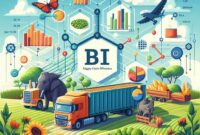The journey of business intelligence (BI) software is a fascinating story of innovation and transformation. Tracing the history of business intelligence software reveals significant milestones and groundbreaking developments that have shaped the way organizations collect, analyze, and utilize data. From the early days of data processing to the sophisticated, AI-powered tools we use today, the evolution of BI software has been marked by continuous advancements, each contributing to the efficiency and effectiveness of business operations.
The Beginnings of Business Intelligence Software
The concept of business intelligence dates back to the mid-20th century, but it wasn’t until the 1970s that the first recognizable BI software emerged. During this period, companies began to see the potential of computer-based data processing. Early BI tools were primarily used for simple data analysis and reporting, which, although rudimentary by today’s standards, laid the foundation for future developments.
The 1980s: The Rise of Decision Support Systems
In the 1980s, the term “Decision Support System” (DSS) became popular. These systems were designed to assist managers in making informed decisions by providing relevant data and analytical tools. DSS software represented a significant leap from basic data processing, incorporating more sophisticated data analysis and modeling capabilities. This decade also saw the introduction of relational databases, which significantly improved data storage and retrieval processes.
The 1990s: The Birth of Modern BI Tools
The 1990s marked the birth of modern BI tools as we know them today. This era witnessed the introduction of data warehouses, which allowed organizations to store large volumes of data from various sources in a centralized location. The development of Online Analytical Processing (OLAP) tools enabled users to perform complex queries and analyze data in multiple dimensions. Additionally, the emergence of graphical user interfaces (GUIs) made BI tools more accessible to non-technical users, broadening their adoption across different business functions.
The 2000s: The Age of Advanced Analytics
The early 2000s brought significant advancements in data analytics, with the introduction of more sophisticated BI tools capable of advanced data mining, predictive analytics, and real-time data processing. Companies began to leverage these tools to gain deeper insights into their operations and market trends. The integration of BI tools with other enterprise systems, such as Customer Relationship Management (CRM) and Enterprise Resource Planning (ERP) systems, further enhanced their value.
The Evolution of BI Software Capabilities
During this decade, BI software evolved to include features like automated reporting, dashboard visualization, and mobile accessibility. These innovations allowed users to access critical business information on the go and make decisions faster than ever before. Moreover, the rise of cloud computing began to influence BI software, making it more scalable and cost-effective for businesses of all sizes.
The 2010s: The Era of Big Data and AI
The 2010s were characterized by the explosion of big data and the integration of artificial intelligence (AI) into BI software. Organizations now had access to unprecedented volumes of data generated from various sources, including social media, IoT devices, and transactional systems. BI tools evolved to handle this massive influx of data, providing more powerful analytics capabilities and uncovering insights that were previously unattainable.
AI and Machine Learning in BI
AI and machine learning (ML) became integral components of BI software during this period. These technologies enabled predictive analytics, anomaly detection, and natural language processing (NLP), making it easier for users to interact with data and extract meaningful insights. Automated data preparation and smart data discovery tools further streamlined the analytics process, reducing the time and effort required to analyze large datasets.
The 2020s and Beyond: Future Trends in BI Software
As we move through the 2020s, BI software continues to evolve rapidly. Emerging trends such as augmented analytics, which combines AI with BI, are poised to revolutionize the way organizations interact with data. Augmented analytics uses AI to automate data preparation, insight generation, and even decision-making, allowing users to focus on strategic tasks rather than data manipulation.
The Role of Cloud and Edge Computing
Cloud and edge computing are also playing a crucial role in the future of BI software. Cloud-based BI solutions offer greater flexibility, scalability, and cost-effectiveness, making advanced analytics accessible to businesses of all sizes. Edge computing, on the other hand, allows data processing to occur closer to the data source, reducing latency and enabling real-time analytics.
Emphasis on Data Privacy and Security
With the increasing volume of data being processed, data privacy and security have become paramount concerns. BI software vendors are investing heavily in developing robust security features and compliance mechanisms to protect sensitive information and ensure regulatory compliance.
Conclusion
Tracing the history of business intelligence software reveals a remarkable journey of technological advancements and innovation. From the early days of basic data processing to the current era of AI-powered analytics, BI software has continually evolved to meet the changing needs of businesses. As we look to the future, the integration of augmented analytics, cloud computing, and advanced security measures promises to further enhance the capabilities and impact of BI tools, empowering organizations to make smarter, data-driven decisions.
FAQ
1. What is business intelligence (BI) software? Business intelligence (BI) software refers to tools and applications used to collect, analyze, and present business data. These tools help organizations make informed decisions by providing insights into their operations and market trends.
2. How has BI software evolved over the years? BI software has evolved from simple data processing tools in the 1970s to sophisticated, AI-powered analytics platforms today. Key milestones include the rise of decision support systems in the 1980s, the introduction of data warehouses and OLAP tools in the 1990s, and the integration of AI and big data analytics in the 2010s.
3. What are the current trends in BI software? Current trends in BI software include augmented analytics, cloud computing, edge computing, and a strong emphasis on data privacy and security. These trends are driving the development of more advanced, scalable, and secure BI solutions.
4. How do AI and machine learning impact BI software? AI and machine learning enhance BI software by enabling advanced analytics capabilities such as predictive analytics, anomaly detection, and natural language processing. These technologies help automate data preparation, insight generation, and decision-making processes.
5. Why is data privacy and security important in BI software? Data privacy and security are crucial in BI software because businesses handle large volumes of sensitive information. Ensuring data protection and regulatory compliance is essential to maintain trust and avoid legal repercussions.



